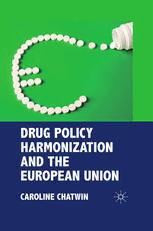
Drug Policy Harmonization and the European Union PDF
Preview Drug Policy Harmonization and the European Union
Drug Policy Harmonization and the European Union Drug Policy Harmonization and the European Union Caroline Chatwin UniversityofKent,UK Palgrave macmillan ©CarolineChatwin2011 Softcoverreprintofthehardcover1stedition2011978-0-230-27186-9 Allrightsreserved.Noreproduction,copyortransmissionofthis publicationmaybemadewithoutwrittenpermission. Noportionofthispublicationmaybereproduced,copiedortransmitted savewithwrittenpermissionorinaccordancewiththeprovisionsofthe Copyright,DesignsandPatentsAct1988,orunderthetermsofanylicence permittinglimitedcopyingissuedbytheCopyrightLicensingAgency, SaffronHouse,6-10KirbyStreet,LondonEC1N8TS. Anypersonwhodoesanyunauthorizedactinrelationtothispublication maybeliabletocriminalprosecutionandcivilclaimsfordamages. Theauthorhasassertedherrighttobeidentified astheauthorofthisworkinaccordancewiththeCopyright, DesignsandPatentsAct1988. Firstpublished2011by PALGRAVEMACMILLAN PalgraveMacmillanintheUKisanimprintofMacmillanPublishersLimited, registeredinEngland,companynumber785998,ofHoundmills,Basingstoke, HampshireRG216XS. PalgraveMacmillanintheUSisadivisionofStMartin’sPressLLC, 175FifthAvenue,NewYork,NY10010. PalgraveMacmillanistheglobalacademicimprintoftheabovecompanies andhascompaniesandrepresentativesthroughouttheworld. Palgrave®andMacmillan®areregisteredtrademarksintheUnitedStates, theUnitedKingdom,Europeandothercountries. ISBN978-1-349-32281-7 ISBN978-0-230-30683-7(eBook) DOI 10.1057/9780230306837 AcataloguerecordforthisbookisavailablefromtheBritishLibrary. LibraryofCongressCataloging-in-PublicationData Chatwin,Caroline,1978– DrugpolicyharmonizationandtheEuropeanUnion/CarolineChatwin. p. cm. Includesindex. 1. Drugabuse—Governmentpolicy—EuropeanUnionCountries— Evaluation. 2. Drugcontrol—EuropeanUnionCountries— Evaluation. I. Title. HV5840.E8C432011 362.29(cid:2)1561094—dc22 2011004889 10 9 8 7 6 5 4 3 2 1 20 19 18 17 16 15 14 13 12 11 Contents ListofTables vi Introduction vii Part I Harmonization,DrugPolicyandthe EuropeanUnion 1 PolicyMakingataEuropeanLevel 3 2 DrugPolicyintheEuropeanUnion 28 3 StatisticalInformationontheDrugProbleminthe EuropeanUnion 47 Part II DrugPolicyinIndividualMemberStates 4 Sweden 89 5 TheNetherlands 105 6 Denmark 121 7 Portugal 130 Part III Multi-levelGovernanceandtheWay ForwardforEuropeanDrugPolicy 8 Multi-levelGovernanceandtheWayForwardforEuropean DrugPolicy 149 References 165 Index 178 v List of Tables 3.1 Lifetimeprevalencealladults:lastsurveyavailablefor eachmemberstate(from2000onwards) 50 3.2 Lifetimeprevalenceyoungadults:lastsurveyavailable foreachmemberstate(2000onwards) 52 3.3 Last12monthsprevalencealladults:lastsurvey availableforeachmemberstate(2000onwards) 54 3.4 Last12monthsprevalenceyoungeradults:lastsurvey availableforeachmemberstate(2000onwards) 56 3.5 Estimatesofprevalenceofproblemdruguseatnational level,summary2003–08,rateper1000,age15–64 60 3.6 PrevalenceofHIVinfectionamonginjectingdrugusers intheEU,2008ormostrecentyearavailable 65 3.7 Summaryofcharacteristicsofthedeceasedin drug-induceddeathsaccordingtonationaldefinitions 68 3.8 Druglawoffences1995–2008,part(i)numberofreports ofoffences 71 3.9 Druglawoffences1995–2008,part(ii)methodological notes 73 3.10 Quantities(kg)ofheroinseized,1995–2008 76 3.11 Quantities(kg)ofcocaineseized,1995–2008 78 3.12 Quantities(kg)ofamphetamineseized,1995–2008 80 vi Introduction Theissueofillicitdrugsis,undeniably,aninternationalone.Drugsthat originate in one country will often be trafficked through other coun- triesbeforebeingconsumedelsewhere.Norisitjustthesegeographical facts that make drugs an international issue. Every country has people withinitthatusedrugsaswellaspeoplethathavebecomeproblematic intheiruse,makingtheissueinternationalinthesensethatitisuniver- sal–onethatisexperiencedbyallsocietiesandonetowhichthosein authoritymustseeksolutions.Thereissomesenseofthisinternational facettotheissueofillicitdrugsinthatmanycountriesaresignatoriesto international conventions committing them to a broadly similar style of drug policy centred around the notion of prohibition. International bodies,suchastheUnitedNations(UN)throughitsofficeondrugsand crime, or the European Union (EU) through its monitoring centre for drugs and drug addiction, also seek to take ownership of the problem andtodevelopstrategiesthatwillbeemployedacrosstheglobe. Largely,however,individualcountrieshavedevelopedtheirdrugpoli- ciesinisolation,resultinginawidevarietyofpoliciesbeinginoperation today.Thisindividualizationofnationaldrugpolicyhasmostobviously occurredsincethewell-documentedexplosionofdruguseinthe1960s whenthelinkbetweendrugsandpopularculturewasforged.Different countries reacted in various ways to this initial rise in use and, since then, have developed policy along, in some cases, radically different lines. While all countries can agree that drug trafficking should be pri- oritized and drug traffickers should be met with the full weight of the law,itisintheirattitudestowardsdruguseanddrugusersthatmostof thepolicydifferencesaretobeseen.Somegovernmentshaveconceptu- alizeddrugusersaseitherdiseasedandinneedofhelporyoungandin an experimental phase of their lives, and, as such, have afforded them a certain degree of leniency and tried to protect them from unneces- sarycontactwiththecriminaljusticesystem.Othershavepursueddrug usersasaggressivelyasdrugdealersandtraffickersastheybelievethatif drugsaretobeeradicatedfromsocietythendemandreductionmustbe asmuchofapriorityassupplyreduction. Since its inception, in 1951, the EU has grown in both the strength and breadth of its power, until it has become, arguably, the most vii viii Introduction powerfulsupranationalinstitutionintheworldtoday.Whileitsbegin- nings were very much concerned with uniting the economies of the powerhouses of Europe, it has become involved, although less success- fully, with political and social policy. As time has passed, efforts to harmonize and coordinate ever-increasing aspects of national policy in these three areas have grown and European powers have expressed the desire to draw “ever closer”. Drug policy, then, should have been an early contender for the development of a harmonized European agenda.Theinternationalnatureoftheproblem,aswellasitsuniversal- ity,shouldhaveensureditssuitabilityforconcertedintegrativeefforts. Yet it is an area that has remained remarkably resistant to attempts to harmonize. Individual countries have remained wedded to their sep- arate, and often idiosyncratic, national policies and, ultimately, the decisionhasbeenmadetodeclaredrugpolicyanareainwhichnational governmentsshouldretaincontrolofpolicymaking. This book attempts to understand why this has been the case and what the future possibilities are for harmonization in this area. It explores the desirability for harmonized drug policy within the EU, from the perspectives of both the institutions of the EU itself and the headsoftheindividualmemberstates.Italsoconsiderstheviabilityofa harmonizedEuropeandrugpolicyundertraditionaltop-downmethods ofcontrolthroughtheformulationofpolicyatboththeEuropeanand the national level. Finally, it attempts to apply the increasingly popu- lartheoryofmulti-levelgovernancetotheissueofthecontrolofillicit drugs and suggests that, if the aim of a harmonized policy in this area isaseriousone,thenmulti-levelgovernancepresentstheonlyrealistic wayforwardtoachievethisaim. Aguidetothisbook In order to systematically and comprehensively examine the possibili- ties for harmonization of drug policy at the European level, this book has been divided into three distinct parts. The first deals with harmo- nization of policy, including drug policy, in the EU, the second with historical case studies of the development of drug policy in individual member states and the third with a summary of both the desirability andtheviabilityofaharmonizedEuropeandrugpolicyandtheapplica- tionoftheEuropeanintegrationtheorymulti-levelgovernancetopolicy developmentinthisarea. Chapter1outlineskeyconceptsandtheoriesrelevanttotheharmo- nization debate in Europe and gives a historical presentation of the Introduction ix development of economic, political and social policy at a European level.Chapter2chartsthecourseofthedevelopmentofdrugpolicyat aEuropeanlevelanddocumentsthefundamentalinabilityofEuropean powerstodecidewhetherabroadlyliberalorbroadlyrepressivestrategy is more appropriate in seeking to control this issue. Statistics collected by the European Monitoring Centre for Drugs and Drug Addiction are presentedandcritiquedinChapter3.Ultimatelytheyarejudgedtobe toobesetbycomparativeproblemsandtooinconclusivetoprovideevi- dence of the superiority of either a liberal or a repressive drug policy approach. In the second part of the book, the variety of national drug pol- icy currently in operation within the EU is explored in more detail. The introduction to this part provides a brief round-up of current pol- icy practices in Europe and emphasizes the differences between them. The drug policies of Sweden, the Netherlands, Denmark and Portugal are then examined in more detail in the following four chapters using a historical framework for analysis. The policies of Sweden and the Netherlands have been chosen for further exploration due to their respectivepositionsatoppositeendsoftheliberal–repressivedrugpolicy continuum.Sweden,withitsaimofadrug-freesocietyanditsstrategy of targeting users as much as dealers, represents a relatively restrictive drug policy and the Netherlands, with its strategies of normalization of drug use and separation of the markets, represents one that is rela- tivelyliberal.Together,thecasestudiesprovidedforthesetwocountries demonstrate the depth of difference in national style of drug policy in operationinEurope. While Sweden and the Netherlands are revealed as being strongly attached to their national drug policies, other countries within Europe have shown more willingness to change policy direction in recent years. The case studies of Denmark and Portugal have been chosen to reflectthistendency.Denmarkhaslongbeenacountrywithanational drugpolicythatfalls directlyin between Sweden andthe Netherlands: law enforcement strategies have been consistent and sometimes force- fully applied, yet cannabis users have been treated relatively leniently. Since2001,however,Denmarkhasabandonedthisstrategyofleniency towards cannabis users and has introduced a raft of new measures directed against them. Portugal, meanwhile, introduced a radical new lawin2001basedfirmlyontheprincipleofharmreductionanddecrim- inalizing the possession of all drugs for personal use. Case studies of these two countries therefore evidence movement towards both more liberalandmorerepressiveapproachestodrugpolicywithinEuorpe.
